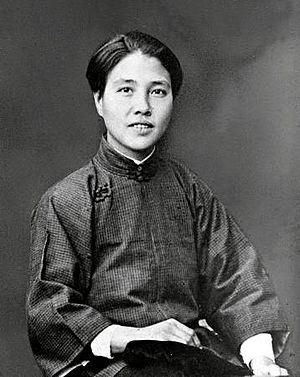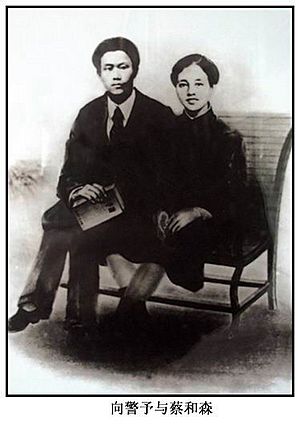Xiang Jingyu facts for kids
Quick facts for kids
Xiang Jingyu
|
|
|---|---|
| 向警予 | |
 |
|
| Member of the Central Committee of the Chinese Communist Party | |
| Personal details | |
| Born | 4 September 1895 Xupu, Hunan |
| Died | 1 May 1928 (aged 32) |
| Nationality | Chinese |
| Political party | Chinese Communist Party |
Xiang Jingyu (Chinese: 向警予; pinyin: Xiàng Jǐngyǔ; Wade–Giles: Hsiang Ching-yü, born September 4, 1895 – died May 1, 1928) was an important leader in China. She was one of the first women to join the Chinese Communist Party (CCP). Many people see her as a pioneer who helped start the women's movement in China. She worked hard to improve the lives of women and bring about big changes in her country.
Contents
Early Life and Education
Xiang Jingyu was born in Xupu, a place in Hunan province, on September 4, 1895. Her father, Xiang Ruiling, was a successful businessman. Her mother, Deng Yugui, passed away when Xiang Jingyu was young. She had ten brothers and sisters.
Her brother, Xiang Xianyue, had studied in Japan. He was a leader of a group called Tongmenghui in West Hunan. In 1903, he started a primary school. Xiang Jingyu, whose name was then Xiang Junxian, went to this school. She was the first girl to study in a school in that part of China during the old imperial times.
Moving to Changsha and Patriotic Actions
In 1911, after the Qing Dynasty ended with the Xinhai Revolution, Xiang Jingyu moved to Changsha. She changed her name to Xiang Jingyu. She first attended the First Provincial Women's Normal School of Hunan, then moved to Zhou Nan Women's School.
During this time, she cared deeply about China's future. When the unfair “Twenty-One Demands” were signed, she and other students spoke in the streets. They wanted to inspire Chinese people to be proud of their country and fight for its rights.
Starting a New School
After finishing school, Xiang Jingyu returned to her hometown. She believed that education could help China become stronger. So, she started the Xupu Primary School with help from local supporters. As the principal, she hired young, forward-thinking teachers. Unlike most schools, her school taught new ideas and knowledge. It started with just one class and a few dozen students. But soon, it grew quickly to about 300 students.
Meeting Future Leaders and Studying Abroad
In April 1918, Mao Zedong and Cai Hesen started the New Citizen's Academic Association in Hunan. Xiang Jingyu wanted to do more for her country. She went to Beijing and met Mr. Cai Yuanpei, the head of Peking University. In Beijing, she also met Cai Hesen and they became good friends.
In July 1919, Cai Hesen invited her to Changsha to help with a program. This program allowed Chinese students to work and study in France. In December, Xiang Jingyu, Cai Hesen, Cai Chang, Cai Hesen's mother, and others traveled to France. Xiang Jingyu attended the Montargis Women's University. While studying there, she read many books by Karl Marx. This led her to believe in Marxism and Communism. In May 1920, Xiang Jingyu and Cai Hesen got married.
While in France, she thought a lot about the world and China. In May 1920, she wrote an article for Chen Duxiu’s magazine, New Youth. In her article, she said that women's freedom must be connected to changing society as a whole.
Joining the Revolution
In 1921, many Chinese students in France were sent back to China. This happened after they protested for better study and living conditions. Xiang Jingyu returned to China that same year.
Becoming a Communist Party Leader
In February 1922, Xiang Jingyu joined the Chinese Communist Party. She was one of the first women to become a member. In July, she was chosen as the first female member of the CCP Central Committee. She also became the first director of the party's Women's Bureau. She worked to connect with female workers, especially those in the silk industry. Xiang Jingyu wrote many articles about the problems faced by Chinese women. She urged Chinese women to unite and fight for their freedom.
In 1923, the Communist Party joined with another group called Kuomintang. Xiang Jingyu became an editor for a weekly newspaper supplement. In June 1923, at the 3rd National People's Congress, she was again elected to the Central Committee. She became the first secretary of the Women’s Movement Committee. Xiang Jingyu wrote a plan for the women's movement, which the Congress approved. This plan said that a main goal of the party's Women's Bureau was to guide the overall women's movement. She sometimes spoke out against old-fashioned practices within the Communist Party that treated women unfairly.
Leading Women Workers
In 1924, she led a big strike involving about ten thousand female workers from silk factories. After this, Xiang Jingyu started the Committee of Women's Liberation. She trained many women leaders who then helped fight against old traditions and foreign control.
In January 1925, Xiang Jingyu was elected to the Central Committee for a third time. She played a very important role in the strikes and protests of the May Thirtieth Movement of 1925. However, she faced some personal challenges and criticism from party members, which led to her stepping down from her leadership roles on the Central Committee and as head of the party's Women's Bureau.
Later Years and Return to China
In October, Xiang Jingyu and Cai Hesen were sent to study in Moscow, Russia. Their relationship ended during this time. In March 1927, Xiang Jingyu came back to China.
On April 12, Chiang Kai-shek started a war against Communists in Shanghai. Xiang Jingyu decided to go to Wuhan and work in the Propaganda Department for the Federation of Trade Unions. Even when the government in Wuhan also started to expel Communists in July, Xiang Jingyu bravely stayed. She continued to edit the party newspaper, Chang Jiang, and helped workers and the secret Party groups.
Death
Xiang Jingyu was arrested in Wuhan on March 20, 1928. This happened because some members of her group betrayed her to the police. French officials handed her over to the Nationalist government in April. On May 1, 1928, Xiang Jingyu was executed by the police. She died fighting for her beliefs and for the rights of the Chinese people, especially women.


